Corporate Competitor Analysis Tactics to increase competitive win rate
Competitive Analisis Report (Part II): Spot the different types of competition and evaluate your competitors to better compete with them.
How to conduct a competitive intelligence analysis that will enable your sales, marketing, and product teams. It's all about understanding your competitors and why you win.
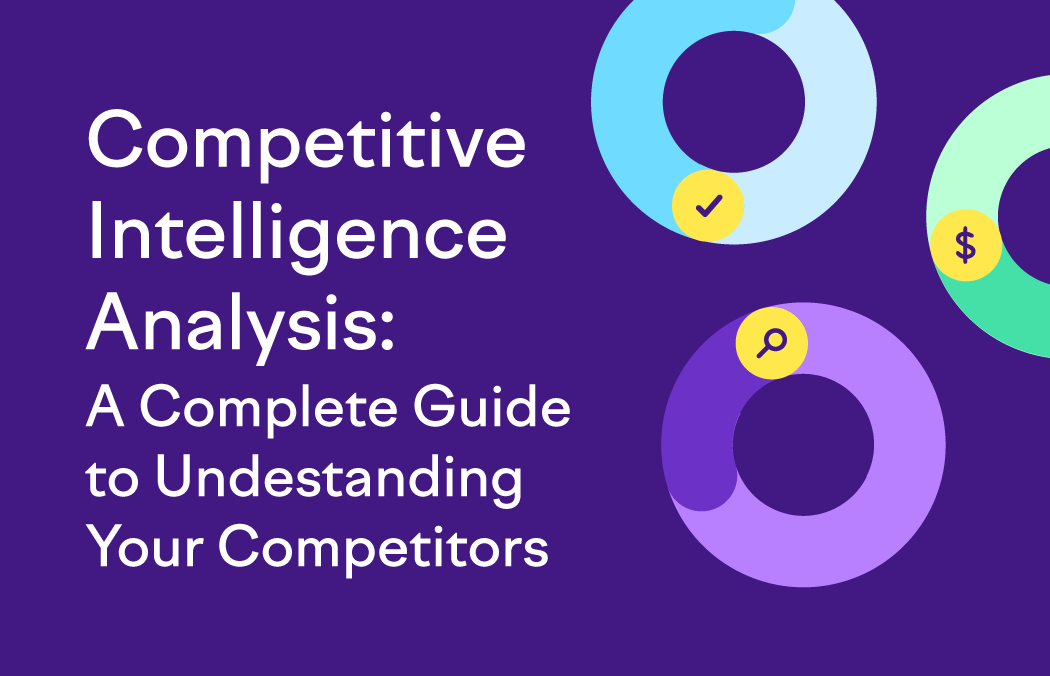
Would you like to gain a competitive edge in your industry? Want to better understand your competitors and enable your sales team to close more deals, deliver more powerful go-to-market plans, and make more informed business decisions?
Look no further! In this comprehensive Competitive Intelligence Analysis Guide, we'll show you how to gather and analyze information about competitors, customers, and market trends to your advantage.
You'll learn the importance of conducting a competitive intelligence analysis, what information you should be gathering, and the tools and techniques you can use to analyze and distribute this information so that it gets used.
Follow along: Get this easy-to-use template you can use to follow each step of our competitive intelligence analysis workflow.
A competitive intelligence analysis is the process of gathering, analyzing, and disseminating information about competitors, markets, and industry trends in order to get a clear view of the competitive landscape at a given point in time. This is often done on a quarterly or semi annual basis and is intended to provide a comparison between competitors offering similar products or services.
Competitive intelligence, on the other hand, can refer to a program wherein insights are constantly gathered, analyzed, and shared or it can mean the actual insights themselves.
This guide focuses on conducting a periodic competitive intelligence analysis.
The information you’ll include in your competitive intelligence analysis may include:
Competitive intelligence analysts, product marketing managers, and sales enablement specialists use a variety of tools and techniques, such as market research, industry analysis, and competitive analysis, to gather and analyze this information.
Information can be gathered manually by visiting publicly-available websites and offline sources or automatically by software like Kompyte that scans hundreds or thousands of blogs, websites, social media properties, review sites, job boards and more.
The insights must then be filtered to surface only what is valuable. When done manually, this can take many hours. With the aid of competitive intelligence automation, it takes a couple of hours to set up and then about an hour a week to maintain.

The insights and recommendations derived from this analysis are then disseminated to relevant stakeholders within the organization, such as executives, managers, and sales teams, to inform decision-making and strategy. This can be done in a meeting with your teams, but it should also be readily accessible to everyone on a shared drive. 
Remember, this is not a full competitive intelligence program, but a periodic comprehensive review of the competitive landscape.
Depending on your industry, you may have dozens of competitors or you may have only one or two. Regardless, you may wish to start with no more than five so you can more thoroughly analyze each of them.
As to who you should analyze, ask yourself what products or services your potential customers use instead of your own? Take note of the various levels of competitors:
Of course, you’ll focus more on direct competitors than replacement competitors, but it’s good to be aware of all of them, especially since it may not take a big change in offerings or features to turn them into a direct competitor if your audience is similar.
Write a brief description of each competitor. This description can be in your own words and can usually be taken from a company’s “about” or home page.
Take a look at each competitor’s LinkedIn profile to determine the number of employees and the location of the company. Other online resources for startups, such as CrunchBase or AngelList, can also include this information and if your competitors are there, will enable you to complete the rest of the corporate competitive analysis.
Analyzing your competitors’ product and service offerings in terms of features and value gives you an idea of your strengths and weaknesses when compared to competitors.
Following our template, list your company’s product features as columns. In the rows, note how the competition compares by assigning a symbol for “Yes, No or Partial.”
The plan is to share this analysis with others in your company, so it’s important to make relevant notes as you analyze each feature.
Note any proprietary features the competition claims. Depending on your industry, take note of any other major features that will affect your company. For example, if you are in the tech and software industry, keep track of integrations.
Compare the competitors’ offerings to your own, analyzing comparative strengths and weaknesses.
Take a look at the competition’s pricing and pricing structure. Include detailed information such as shipping fees, warranty options, and add-ons. You can also make observations about subscription services – do they have monthly or annual options (with or without discount) or is it a one-time payment?
How does their pricing compare to yours? If you notice your pricing is drastically different from the rest of the market it may be time to reconsider your strategy. If you offer more robust features, it will be of vital importance to make that very clear if you are to justify a substantially higher price point.
When you understand the marketing and messaging used by your competitors, you’ll have valuable insights into their business models, target markets, and overall position in the competitive landscape.
These insights help you make better decisions about how to market your own products and services for a competitive advantage. You’ll find ways to differentiate yourself, and spot areas of weakness you can exploit.
Keeping an eye on a competitor’s marketing and messaging can help you spot upcoming product and feature launches, new marketing campaigns, and changed messaging which could indicate a shift in their target market, or present a new threat to your product. It’s also worth asking yourself if they might have noticed something you haven’t that has led them to, say, start focusing on a message of sustainability, or address current issues such as economic conditions.
When you analyze the success of your competitor’s marketing efforts (such as by watching for social engagement or website traffic and mentions), you can see what is working and what isn’t, which can help you improve the effectiveness of your own marketing.
Here, Kompyte shows you the most-engaged content on your competitors’ social channels. The “$” indicates a likelihood that the post is sponsored.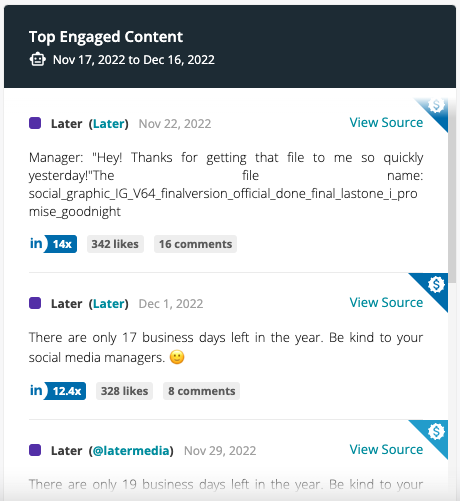
Here’s a simple framework you can use to analyze your competitors’ marketing and messaging:
Identify each competitor’s target audience, main messaging, and tagline. Make sure to include your own.
Find out where your competitors are advertising, what they’re advertising, and the messaging they’re using in their ads.
Don’t forget to identify whether your competition sells business-to-business or business-to-consumer. Turn to competitor social media analysis or read product reviews to answer this. How are they selling their products? Do they have direct sales, resellers, or a multi-level channel? Notice what their sales structure looks like and how many members are in their sales team.
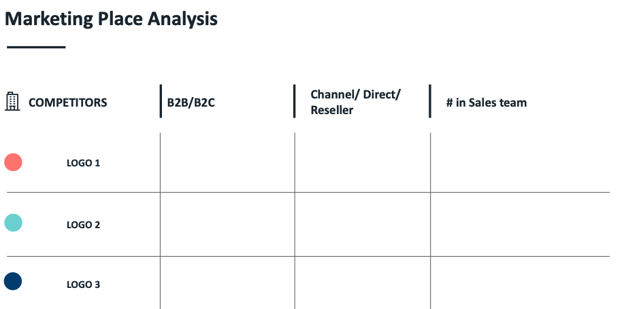
LinkedIn can help you discover how big your competition’s sales team is and new positions they are hiring for – just go to their company page and select “Jobs.” Take a look at sales jobs in particular. Are they focusing on specific markets or hiring in new countries/regions or for new products? Keep this in mind as you craft your competitive insights.
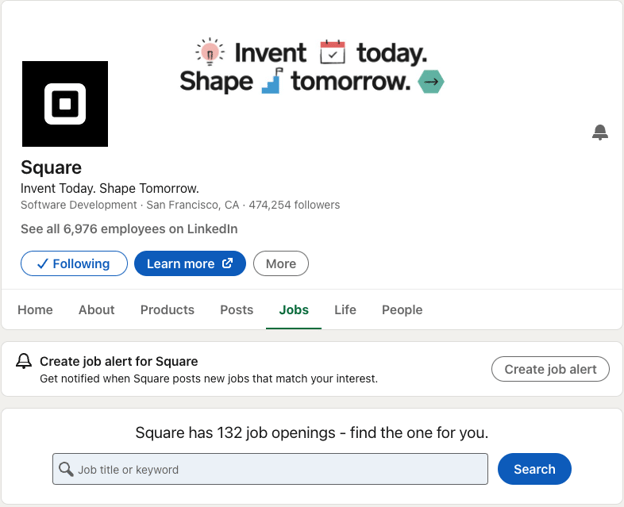
Lastly, track down as many ads and promotions as you can. Check their social media, website, blog posts, and online advertising. Notice how they are speaking to their customers – does their brand present a distinct personality? Note the type of interactions they have with customers. Review press releases or announcements to discover any promotions or partnerships they may have.
Here, we’ve used a Kompyte Smart Filter to look for competitor partner updates. We can see that Insightly has a new partner, and Freshworks updated some details of a partnership.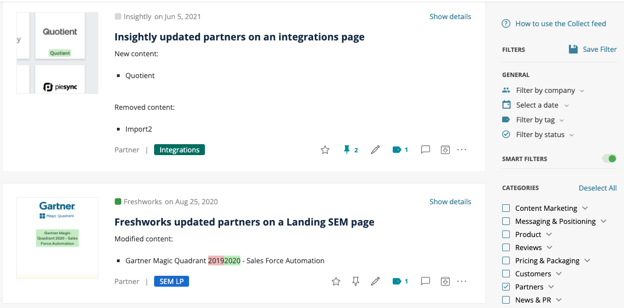
Summarize your key insights regarding your competitors’ marketing strategy, as well as opportunities to enhance your own marketing strategy. Here again our competitive intelligence analysis template will be very helpful.
Let go of all bias and ego to evaluate the marketplace as a potential buyer would. Why would they ultimately choose you over the competition or the competition over you? Is their quality better? Is their design more appealing?
Be sure to take a look at any proprietary features they offer. Finally, develop three strong points that you as a consumer would consider to be their competitive advantage.
Next (and this is easier!), examine their weaknesses. Once again, be objective and dig deep! Just because you believe your competition doesn’t have an exact match of your features, it’s possible that consumers perceive their features as a valid substitute.
The ability to honestly evaluate your brand's strengths and weaknesses when compared with the competition is crucial to understanding why you win.
Your aim is to come up with three genuine weaknesses for each competitor. Consider taking a look at the product reviews and customer comments for your competitors. Websites such as Glassdoor, Capterra, TrustRadius, Software Advice, and G2 Crowd can all be used to view real customer evaluations for potential strengths and weaknesses you hadn’t considered.
Make sure to do the same for your own product.
"Kill points" in sales are statements used to exploit where a competitor's product or service is weak, and where your own product or service has a significant advantage.
Using the competition’s strengths and weaknesses, develop three kill points, neutralizing each of your competitor’s strengths and emphasizing their weaknesses by pointing out how your solution benefits the client better.
For example, if you know that one of your competitor’s weaknesses is “paid phone support”, but your company offers “free phone support”, your kill point could be “We offer free phone support, so you can speak to us directly at no additional cost.”
Your kill points should not mention the competition directly. Don’t worry – if your lead is speaking to you, they’re probably also speaking to the competition and will likely make that connection themselves.
Remember, don’t just focus on features. When consumers make a final decision, they focus on value! You can use these Battlecards as a tool to demonstrate the value being offered by your products/services.
If you include a feature as a strength, it’s important to analyze exactly why it is a strength. What problem does it solve for your customers, and why exactly is it beneficial? Lastly, don’t just tell your prospects, show them. Use any specific data you have. Real numbers strengthen your position.
In one of the final steps of your competitive analysis, we’ll take a look at external factors that may affect your company. Although it’s entirely possible that there isn’t much you can do to alter these factors, it is important to be aware of them so you can begin any product development or necessary changes to your business strategy and product roadmap, potentially doing so before your competitors notice the change.
These factors could include new laws passed in your industry, technological changes, environmental factors that could affect your supply, etc. It’s important to analyze all the conditions surrounding your business. They can lead to product innovation, regardless of whether they are related to the competition or other external factors.
Are there new laws being discussed that would alter your business operations? For example, the automotive industry will need to begin meeting increasingly higher global emissions standards. Make sure to analyze political forces beyond your home country, especially if your company is planning to expand outside of the country anytime soon.
Economic Conditions
Changing economic environments may put pressure on your company. Use data such as industry association reports or annual State of the Industry reports from McKinsey to understand if your industry is expected to grow or decline. This can help you develop more accurate sales forecasts or more closely match your supply to expected demand. These reports may also be able to help you understand new customer demographics you should begin to target or give you ideas for future product offerings.
Technological Advancement
Companies that don’t evolve will die out. Analyzing developing and declining technology will give you an idea of where your company should be moving forward. If you’re watchful and creative, you may be able to secure an early advantage.
Social Climate Changes
Attitudes and social demographics are always changing, and social norms often follow technological trends. For example, today it is much more common to communicate by text than phone call. Stay current on new social norms or lifestyles to keep your marketing and product strategy fresh and modern.
Use each section of your completed competitive analysis, specifically the summary pages, to develop a realistic outlook of the opportunities and threats facing your company.
If your marketing & messaging analysis revealed your competitor is expanding quite strongly into one of your key markets, this could be a threat. Make sure to keep this on your radar and continue to track their growth and movement moving forward.
Likewise, if your pricing analysis reveals your company’s pricing is not in line with the industry standard, you may want to evaluate if customers perceive your product value to be significantly higher or if you should reassess your pricing. In the competitor strengths and weaknesses analysis, if you notice your competitor’s customers are dissatisfied with their product, this could be an opportunity for your company to fill that void.
Develop action points for your company to improve and better compete with the competition and win in your unique marketplace. After you’ve completed this analysis, return to your Executive Summary, and map out your key takeaways and company action points.
Forming an action plan with next steps takes your competitive intelligence analysis from interesting exercise to business-changing initiative.

A Battlecard is a document that provides a quick and easy-to-understand summary of key information about a competitor or product. Battlecards provide salespeople, marketing teams, and product teams with a clear understanding of a competitor's strengths and weaknesses, as well as information about their products and services - all the information you’ve been collecting.
Salespeople commonly reference Battlecards visible on their screens while they’re on a sales call for assistance in overcoming objections and expertly differentiating your product.
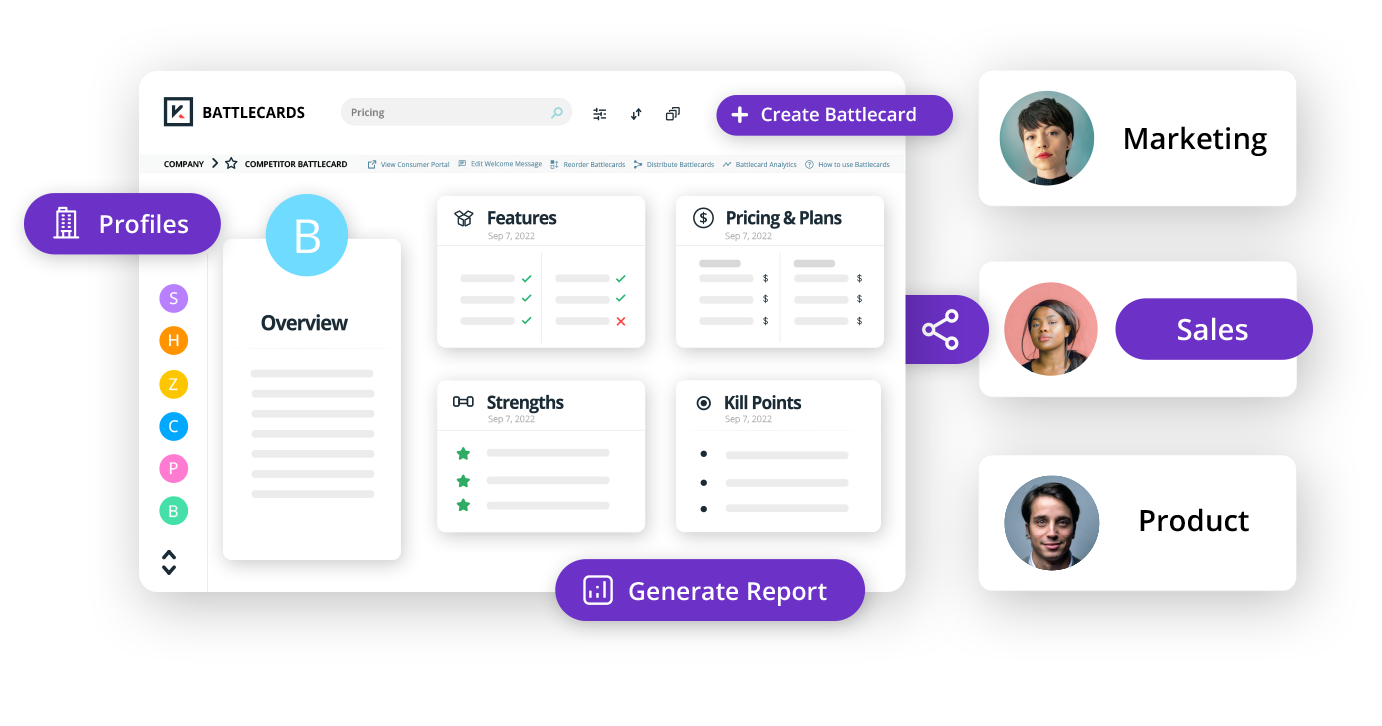
A periodic deep dive into competitive intelligence is a great way to get an overall picture of the competitive landscape and your place in it. However, many small (and not so small) changes can occur in between regularly-scheduled analysis. Getting caught off guard by a new competitor feature or price change is no fun for anyone. That’s why it’s important to monitor competitors constantly.
You can do this manually by creating a list of important web pages to monitor, but it will require many hours of work each week. If you truly don’t want to miss anything and you don’t want to have to filter out the insights from the noise, we suggest implementing competitive intelligence automation.
We'd be happy to show you how it could work for you. Get a demo.
Competitive Analisis Report (Part II): Spot the different types of competition and evaluate your competitors to better compete with them.
Competitor Analysis Report (Part I): Learn about the different parts of a complete competitor analysis and how a competitive analysis can help you...
Competitive Intelligence Academy: Learn how to detect your competition’s promotion immediately
Be the first to know about new B2B SaaS Marketing insights to build or refine your marketing function with the tools and knowledge of today’s industry.